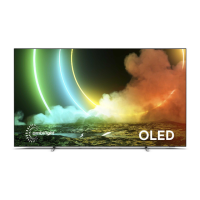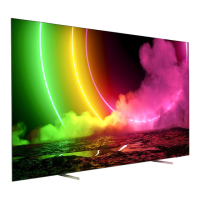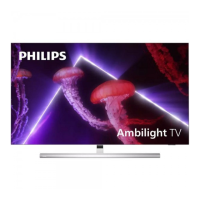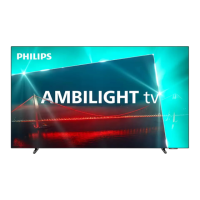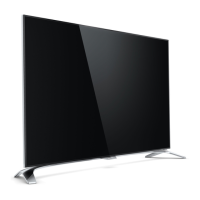Do you have a question about the Philips 55OLED908 and is the answer not in the manual?
Details on normal and deep refreshing processes for OLED screens to protect the display.
Recommendations to prevent image retention and protect the OLED display from damage.
Explains the screen saver function to reduce residual images on the screen.
Introduction to the Google TV experience and Home screen functionality.
Explains how to access and use the Dashboard and its settings for TV configuration.
Differentiates between Google TV and Basic modes and their features.
Instructions on how to open and navigate the TV's Home screen.
Importance of reading safety instructions before using the TV.
Instructions for setting up the TV stand and wall mounting.
Advice on optimal TV placement for viewing and Ambilight.
Guidelines for connecting and handling the power cable.
Instructions for connecting the antenna cable for TV signals.
Instructions for connecting a satellite dish to the TV.
Detailed explanation of all keys on the remote control and their functions.
Step-by-step guide to pair the remote control with the TV for full functionality.
How to use voice commands for searching content on the TV.
Information about the TV's infrared sensor for remote control signals.
Instructions for charging and cleaning the remote control.
Procedures for switching the TV on, off, and into standby mode.
Basic TV operations using physical keys on the TV itself.
Detailed steps for setting up satellite channels.
Information on channel packages offered by satellite operators.
How to set up a Unicable system for satellite reception.
Instructions for manually updating channel lists.
Guide for expert users to manually install channels.
Common issues and solutions related to satellite installation.
Information on operator-specific apps like HD+ OpApp.
Guide to installing TV channels via antenna.
Setting up automatic channel updates.
Process for reinstalling all TV channels.
Steps to reset the TV to factory default settings.
Selecting between free or scrambled channels during setup.
Steps to install new TV channels.
Information about different channel lists and their organization.
How to sort and filter channel lists.
Copying channel lists between TVs using a USB drive.
How to search for specific channels within a list.
Instructions for selecting and watching TV channels.
How to lock channels and set parental controls.
Setting age ratings to restrict access to certain programs.
Available options when watching a channel, like screen off.
Specific accessibility features for hearing impairments.
Accessibility features for visual and speech impairments.
Improving dialogue clarity in audio.
Enabling or disabling HbbTV for specific channels.
Managing cookies stored by HbbTV and operator apps.
Using CAM modules for conditional access.
Configuring CAM modules for CI+/CAM cards.
Explains the concept and benefits of favourite channel lists.
Step-by-step guide to creating custom favourite channel lists.
Adding ranges of channels or editing existing favourite lists.
How to rename custom favourite channel lists.
Accessing and viewing Teletext pages.
Options for customizing Teletext display (freeze, dual screen).
Setting primary and secondary Text languages.
Introduction to interactive TV services and their features.
Explanation of HbbTV technology for interactive content.
Requirements for using interactive TV services.
How to access and navigate interactive TV pages.
Information on how TV Guide data is collected and displayed.
How to search for programs by genre.
Navigating and using the TV Guide features.
Steps to open and close the TV Guide.
Selecting and tuning into a program from the TV Guide.
General advice on connecting devices for optimal quality.
Information about HDMI ports and their capabilities.
Connecting audio systems using HDMI ARC and eARC connections.
Using EasyLink for HDMI CEC device control.
Controlling CEC devices with the TV remote.
Adjusting signal quality settings for individual HDMI ports.
Connecting HTS using HDMI ARC and eARC connections.
Common sound issues with HTS and their solutions.
Connecting audio systems via the optical digital audio output.
Using CI+ modules and smart cards for conditional access.
Connecting smartphones and tablets to the TV.
Connecting a Blu-ray disc player to the TV.
Connecting headphones to the TV for private listening.
Connecting and playing games from a console.
Connecting and using a USB keyboard for text input.
Connecting USB storage devices to view media.
Connecting a camcorder to the TV via HDMI.
Connecting a subwoofer for enhanced audio bass.
Setting up network and internet connections for the TV.
Connecting the TV wirelessly to a network.
Troubleshooting common network connection issues.
Connecting the TV via a wired network connection.
Steps to sign in to your Google Account on the TV.
Instructions on how to launch and use the TV's internet browser.
How to switch to different connected devices or tuners.
Steps to open and use items from the Quick Menu.
Detailed settings for picture quality and appearance.
Selecting and customizing AI-driven picture styles.
Resetting picture styles to default settings.
Automatically applying picture styles based on content.
Protecting the OLED screen from image sticking.
Shifting pixels to reduce screen stress.
Process to clear residual image retention on the screen.
Selecting preset sound styles for different audio content.
Resetting personal sound settings to default.
Enabling or disabling the Ambilight feature.
Selecting Ambilight styles and effects.
Setting Ambilight to follow video content.
Setting Ambilight to follow audio dynamics.
Setting a custom static color for Ambilight.
Using Ambilight to simulate sunset for sleep.
Setting up and using Philips Wireless Home Speakers with Ambilight.
Introduction to available apps and their functions.
Using Google Play Store to download and install apps.
Renting or buying movies and TV shows via Google Play.
Playing music via YouTube Music on the TV.
Playing games from Google Play Games.
Instructions for starting and stopping applications.
Managing installed applications, clearing cache, and uninstalling.
Settings to make the TV more accessible for various needs.
Information about the TV's system software and updates.
Updating the TV's system software for new features and fixes.
Enabling automatic TV software updates.
Resetting TV settings and re-installing software.
Viewing current TV software version and model details.
Setting date and time automatically via network.
Selecting the display language for menus and messages.
Configuring what happens when the TV is turned on.
Activating and configuring energy saving options.
Step-by-step guide to casting content to the TV.
Setting or changing the child lock PIN code.
Locking programs based on age rating.
Enabling or disabling Bluetooth connectivity.
Pairing Bluetooth devices with the TV.
Information and procedures related to the TV's remote control.
Pairing the TV remote control for full functionality.
Updating the remote control's software.
Accessing media files from computers or NAS devices.
Managing favourite media files and folders.
Accessing media files from USB storage devices.
Playing all files or marking folders as favorites.
Playing video files from connected storage.
Viewing photos from connected storage.
Options for viewing and managing 360-degree photos.
Playing music files from connected storage.
Requirements for playing games on the TV.
Connecting and using gamepads for gaming.
Steps to play games from consoles or computers.
Using the gaming control bar for in-game information and settings.
Introduction to Alexa voice service and its capabilities.
Steps to set up and use Alexa for TV control.
Initial setup process for Alexa voice control on the TV.
Environmental information and energy efficiency ratings.
Specifications related to power requirements and consumption.
Details about the TV's operating system (Android OS).
Specifications for TV reception (aerial, tuner bands, DVB).
Specifications for display size and resolution.
Supported input resolutions and refresh rates.
Specifications for TV connectivity options (ports, Wi-Fi).
Specifications for the TV's audio system.
Specifications for supported multimedia file formats and codecs.
Benefits and process of registering the TV.
How to access and use the TV's built-in help system.
Running diagnostic tests to check TV condition.
Solutions for common TV problems and issues.
Steps to resolve issues when the TV does not turn on.
Diagnosing and fixing remote control unresponsiveness.
Resolving issues with finding digital channels.
Resolving issues with no picture or distorted images.
Troubleshooting when sound is present but no picture.
Fixing issues with pictures not fitting the screen correctly.
Resolving issues with no sound or poor audio quality.
Resolving Wi-Fi connection problems.
Improving streaming video quality.
Resolving issues when pairing Bluetooth devices.
Accessing online support resources for troubleshooting.
Information on contacting support and arranging repairs.
General safety precautions for using the TV.
Precautions to prevent electric shock or fire hazards.
Warnings regarding injury and damage to the TV.
Precautions to prevent TV tip-overs and ensure furniture stability.
Safety warnings related to batteries, especially coin/button cells.
Instructions for cleaning and caring for the TV screen.
General terms of use for the television product.
Explanation of pixel characteristics and industry standards.
Information on backlight characteristics like Mura effect.
Specific terms of use for Smart TV features.
Copyright information related to Google TV software.
Copyright and trademark information for HDMI technology.
Information on HEVC patents and decoding.
Copyright and trademark information for NVIDIA G-SYNC.
Copyright and trademark information for AMD FreeSync Premium.
Copyright information for Dolby Vision and Dolby Atmos technologies.
Details on normal and deep refreshing processes for OLED screens to protect the display.
Recommendations to prevent image retention and protect the OLED display from damage.
Explains the screen saver function to reduce residual images on the screen.
Introduction to the Google TV experience and Home screen functionality.
Explains how to access and use the Dashboard and its settings for TV configuration.
Differentiates between Google TV and Basic modes and their features.
Instructions on how to open and navigate the TV's Home screen.
Importance of reading safety instructions before using the TV.
Instructions for setting up the TV stand and wall mounting.
Advice on optimal TV placement for viewing and Ambilight.
Guidelines for connecting and handling the power cable.
Instructions for connecting the antenna cable for TV signals.
Instructions for connecting a satellite dish to the TV.
Detailed explanation of all keys on the remote control and their functions.
Step-by-step guide to pair the remote control with the TV for full functionality.
How to use voice commands for searching content on the TV.
Information about the TV's infrared sensor for remote control signals.
Instructions for charging and cleaning the remote control.
Procedures for switching the TV on, off, and into standby mode.
Basic TV operations using physical keys on the TV itself.
Detailed steps for setting up satellite channels.
Information on channel packages offered by satellite operators.
How to set up a Unicable system for satellite reception.
Instructions for manually updating channel lists.
Guide for expert users to manually install channels.
Common issues and solutions related to satellite installation.
Information on operator-specific apps like HD+ OpApp.
Guide to installing TV channels via antenna.
Setting up automatic channel updates.
Process for reinstalling all TV channels.
Steps to reset the TV to factory default settings.
Selecting between free or scrambled channels during setup.
Steps to install new TV channels.
Information about different channel lists and their organization.
How to sort and filter channel lists.
Copying channel lists between TVs using a USB drive.
How to search for specific channels within a list.
Instructions for selecting and watching TV channels.
How to lock channels and set parental controls.
Setting age ratings to restrict access to certain programs.
Available options when watching a channel, like screen off.
Specific accessibility features for hearing impairments.
Accessibility features for visual and speech impairments.
Improving dialogue clarity in audio.
Enabling or disabling HbbTV for specific channels.
Managing cookies stored by HbbTV and operator apps.
Using CAM modules for conditional access.
Configuring CAM modules for CI+/CAM cards.
Explains the concept and benefits of favourite channel lists.
Step-by-step guide to creating custom favourite channel lists.
Adding ranges of channels or editing existing favourite lists.
How to rename custom favourite channel lists.
Accessing and viewing Teletext pages.
Options for customizing Teletext display (freeze, dual screen).
Setting primary and secondary Text languages.
Introduction to interactive TV services and their features.
Explanation of HbbTV technology for interactive content.
Requirements for using interactive TV services.
How to access and navigate interactive TV pages.
Information on how TV Guide data is collected and displayed.
How to search for programs by genre.
Navigating and using the TV Guide features.
Steps to open and close the TV Guide.
Selecting and tuning into a program from the TV Guide.
General advice on connecting devices for optimal quality.
Information about HDMI ports and their capabilities.
Connecting audio systems using HDMI ARC and eARC connections.
Using EasyLink for HDMI CEC device control.
Controlling CEC devices with the TV remote.
Adjusting signal quality settings for individual HDMI ports.
Connecting HTS using HDMI ARC and eARC connections.
Common sound issues with HTS and their solutions.
Connecting audio systems via the optical digital audio output.
Using CI+ modules and smart cards for conditional access.
Connecting smartphones and tablets to the TV.
Connecting a Blu-ray disc player to the TV.
Connecting headphones to the TV for private listening.
Connecting and playing games from a console.
Connecting and using a USB keyboard for text input.
Connecting USB storage devices to view media.
Connecting a camcorder to the TV via HDMI.
Connecting a subwoofer for enhanced audio bass.
Setting up network and internet connections for the TV.
Connecting the TV wirelessly to a network.
Troubleshooting common network connection issues.
Connecting the TV via a wired network connection.
Steps to sign in to your Google Account on the TV.
Instructions on how to launch and use the TV's internet browser.
How to switch to different connected devices or tuners.
Steps to open and use items from the Quick Menu.
Detailed settings for picture quality and appearance.
Selecting and customizing AI-driven picture styles.
Resetting picture styles to default settings.
Automatically applying picture styles based on content.
Protecting the OLED screen from image sticking.
Shifting pixels to reduce screen stress.
Process to clear residual image retention on the screen.
Selecting preset sound styles for different audio content.
Resetting personal sound settings to default.
Enabling or disabling the Ambilight feature.
Selecting Ambilight styles and effects.
Setting Ambilight to follow video content.
Setting Ambilight to follow audio dynamics.
Setting a custom static color for Ambilight.
Using Ambilight to simulate sunset for sleep.
Setting up and using Philips Wireless Home Speakers with Ambilight.
Introduction to available apps and their functions.
Using Google Play Store to download and install apps.
Renting or buying movies and TV shows via Google Play.
Playing music via YouTube Music on the TV.
Playing games from Google Play Games.
Instructions for starting and stopping applications.
Managing installed applications, clearing cache, and uninstalling.
Settings to make the TV more accessible for various needs.
Information about the TV's system software and updates.
Updating the TV's system software for new features and fixes.
Enabling automatic TV software updates.
Resetting TV settings and re-installing software.
Viewing current TV software version and model details.
Setting date and time automatically via network.
Selecting the display language for menus and messages.
Configuring what happens when the TV is turned on.
Activating and configuring energy saving options.
Step-by-step guide to casting content to the TV.
Setting or changing the child lock PIN code.
Locking programs based on age rating.
Enabling or disabling Bluetooth connectivity.
Pairing Bluetooth devices with the TV.
Information and procedures related to the TV's remote control.
Pairing the TV remote control for full functionality.
Updating the remote control's software.
Accessing media files from computers or NAS devices.
Managing favourite media files and folders.
Accessing media files from USB storage devices.
Playing all files or marking folders as favorites.
Playing video files from connected storage.
Viewing photos from connected storage.
Options for viewing and managing 360-degree photos.
Playing music files from connected storage.
Requirements for playing games on the TV.
Connecting and using gamepads for gaming.
Steps to play games from consoles or computers.
Using the gaming control bar for in-game information and settings.
Introduction to Alexa voice service and its capabilities.
Steps to set up and use Alexa for TV control.
Initial setup process for Alexa voice control on the TV.
Environmental information and energy efficiency ratings.
Specifications related to power requirements and consumption.
Details about the TV's operating system (Android OS).
Specifications for TV reception (aerial, tuner bands, DVB).
Specifications for display size and resolution.
Supported input resolutions and refresh rates.
Specifications for TV connectivity options (ports, Wi-Fi).
Specifications for the TV's audio system.
Specifications for supported multimedia file formats and codecs.
Benefits and process of registering the TV.
How to access and use the TV's built-in help system.
Running diagnostic tests to check TV condition.
Solutions for common TV problems and issues.
Steps to resolve issues when the TV does not turn on.
Diagnosing and fixing remote control unresponsiveness.
Resolving issues with finding digital channels.
Resolving issues with no picture or distorted images.
Troubleshooting when sound is present but no picture.
Fixing issues with pictures not fitting the screen correctly.
Resolving issues with no sound or poor audio quality.
Resolving Wi-Fi connection problems.
Improving streaming video quality.
Resolving issues when pairing Bluetooth devices.
Accessing online support resources for troubleshooting.
Information on contacting support and arranging repairs.
General safety precautions for using the TV.
Precautions to prevent electric shock or fire hazards.
Warnings regarding injury and damage to the TV.
Precautions to prevent TV tip-overs and ensure furniture stability.
Safety warnings related to batteries, especially coin/button cells.
Instructions for cleaning and caring for the TV screen.
General terms of use for the television product.
Explanation of pixel characteristics and industry standards.
Information on backlight characteristics like Mura effect.
Specific terms of use for Smart TV features.
Copyright information related to Google TV software.
Copyright and trademark information for HDMI technology.
Information on HEVC patents and decoding.
Copyright and trademark information for NVIDIA G-SYNC.
Copyright and trademark information for AMD FreeSync Premium.
Copyright information for Dolby Vision and Dolby Atmos technologies.
| Screen Size | 55 inches |
|---|---|
| Display Type | OLED |
| Smart TV | Yes |
| Operating System | Android TV |
| HDMI Ports | 4 |
| HDMI 2.1 | Yes |
| USB Ports | 2 |
| Wi-Fi | Yes |
| Bluetooth | Yes |
| Audio Output | 20W |
| Voice Assistants | Google Assistant |
| Ambilight | Yes |
| Refresh Rate | 120 Hz |
| Resolution | 4K Ultra HD (3840 x 2160) |
| HDR Support | HDR10+, HLG, Dolby Vision |

